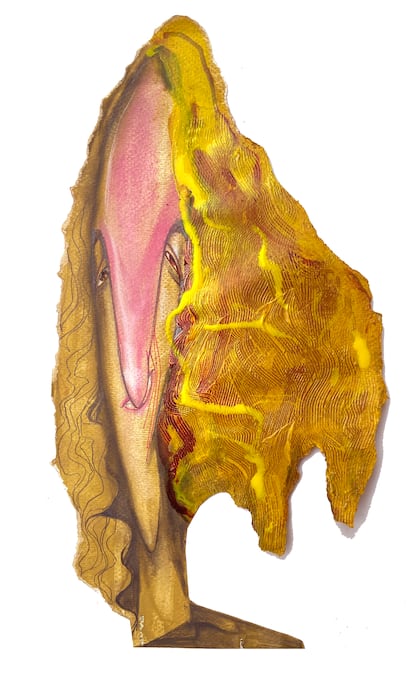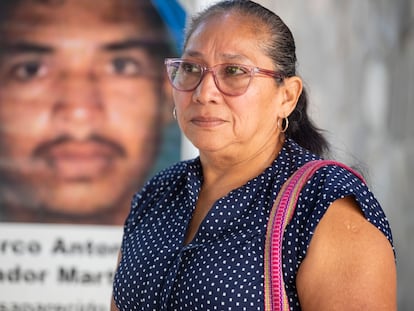Kathryn Schulz, writer: ‘The world is very large, that’s why it’s so incredible to find the ideal person’
The journalist from ‘The New Yorker’ reflects on loss and discovery in ‘Lost & Found,’ a memoir based on the experience of falling in love while mourning the death of her father


The Eastern Shore of Maryland, between Chesapeake Bay and the Atlantic Ocean, is another character in the memoir Lost & Found, by journalist Kathryn Schulz. The other key characters are the author herself and two people to whom the work — one of the most interesting memoirs in recent history — is dedicated. One is her father, a charismatic, loquacious and polyglot Jew, who peacefully died in 2016 at the age of 74, surrounded by his loving family. The other is Casey Cep, Schulz’s wife. The two met 18 months before Schulz’s father’s death, just when the writer — a reporter for The New Yorker and Pulitzer Prize winner for her report “The Really Big One,” about the risk of an earthquake in the Pacific Northwest — thought that true love would elude her forever.
Both stories — each relatable — are intertwined in a diptych about how “astonishing” it is to find something and grief; not only over the loss of a loved one, but also of a necklace, the house keys, the Malaysia Airlines flight MH370 and the rest of the 200,000 objects we lose on average throughout our lives, according to the book, which says that in our lifetime, we will spend six months looking for lost items. “Just as every grief narrative is a reckoning with loss, every love story is a chronicle of finding,” writes Schulz.
The 50-year-old author moved to this corner of Maryland at the request of her wife, who is also a writer and grew up on a farm in one of the rural communities in the area. The interview began in Easton — a town about 15 minutes away from the house where they both live with their daughter, who is just under three years old — and ended in whispers in the public library. It is one of the richest municipalities in the United States, and during the pandemic, it was one of the one of the areas that saw its population increase thanks to remote working. It is also a place with history: located under the Mason-Dixon line — which marked the border between the North and the South — Frederick Douglass, abolitionist politician and writer, and Harriet Tubman, the heroine of the Underground Railroad, were both born under the yoke of slavery. The two escaped their fate, and both are, according to the writer, “among America’s greatest self-made patriots.”
“It’s kind of a miracle that this nation has held together,” Schulz explains. “Meeting Casey was for me also getting to know the South and realizing that the North still regards itself as innocent and heroic. It is obvious that the sin of chattel slavery certainly persisted in the South a lot longer than it did in the North, and did in fact require a war to bring it to an end. But the idea that the North was somehow enlightened and benevolent, championing the equal rights of all peoples, is laughable. The Underground Railroad [a network of houses and people that helped plantation fugitives escape to freedom] did not take enslaved people out of the Deep South and bring them to the North, but rather took them to Canada, because the North was so unsafe and deeply complicit in this system of slavery.”
Slavery persisted longer in the South of the United States, but the idea that the North was benevolent is laughable
Schulz was born in Shaker Heights, a suburb of Cleveland (Ohio), 434 miles from Easton. Cep is also a writer at The New Yorker, but the couple did not meet in the newsroom, but rather thanks to a friend who thought they could get along. The idea of writing Lost & Found, says Schulz, was actually a decision to turn the 6,000-word article she published after her father’s death into a memoir of just over 200 pages. “I feel profoundly lucky to have gotten to write about that. He was a very avid reader of The New Yorker, although I’m sure he would have been very annoyed that he only got into its pages after his death,” she says.
“A couple of people,” including her book editor, suggested that the article contained the seeds of a book, but she was not convinced until one night when the couple was driving “deep in the middle of nowhere in Alabama.” Cep (C. in the book) was investigating the story of the novel that Harper Lee never finished after publishing To Kill a Mockingbird — research that culminated in the book Furious Hours). While in the car, the two started discussing the essay. “I said, ‘it’s not that there’s not more to say, I could always talk about my dad. He was an amazing guy. And there’s certainly always more to say about grief and mourning, but I don’t really want to spend two years of my life thinking about nothing but grief.’ And as we were talking about it, it occurred to me that there was this perfect mirror image story, which was the story of falling in love. Suddenly, the abstract category of loss seemed as interesting to me as discovery: the chance encounters and life-changing discoveries, the accidental revelations and the intentional searching.”
From that talk in the car also came the structure of the memoir, which is divided into three parts. The first part “Lost” talks about grief, the second, “Found” about falling in love, while the last one, “And,” is dedicated to marriage and the conjunction, with its “power” to project us “into the future.” It was Cep that night in Alabama who uttered the expression Lost & Found, a nod also to the lost objects awaiting to be found.
And the book is also about that, the strangeness of finding the right person in the great warehouse of lost souls. And of believing, against all logic, that such a discovery is possible. “That is part of what makes the experience of falling in love feel so miraculous, the feeling that predominates is astonishment,” says Schulz. “The world is very large. Even a tiny piece of it, New York, is very large. That’s why meeting the ideal person is so incredible.”
Falling star
Schulz likes the fact that the Spanish translation of her book is called Falling Star. “The person who chose the title is a smart and careful reader, someone who understood the exact reason that falling stars are important in this book. I’m interested in the relationship between our own kind of tiny little lives and the vast universe we live in. And so I thought, the title was perfect,” she explains. The writer is referring to one of the most interesting passages in the book, which mixes memoir with the literary and philosophical. That passage tells the story of an 11-year-old boy who sees a meteorite fall to the earth, a “falling star,” while returning home one Sunday.

Schulz also defines the book as a kind of “covert poetry anthology.” “Writing about grief and love has been done before. When I sat down to write, I said to myself: why not borrow from the poets, from their incredibly long tradition of using the language of pain and love?” And that is how the verses of Robert Frost, Jack Gilbert, Gerard Manley Hopkins and Elizabeth Bishop ended up on the pages of Lost & Found. “Let’s be honest, the vast majority of people do not spend their free time reading poetry, but they do have a certain familiarity with it,” says Schulz. “Do you know when they hear it? When they go to church or synagogue. When they get married, or when they attend a funeral. And I think that’s because poetry can get them closer to the bone of pure emotion, even people who would never look at a book.”
When asked if the abundant number of books on grief helped her get through her experience or, at least, write her memoir, Schulz — who before being a reporter was a literary critic — answers bluntly: “No.” “In my case, poetry helped me much more. The process of overcoming the death of a loved one is very personal, it is part of what makes it complex,” she explains. “Those kinds of stories don’t usually move me, although maybe I shouldn’t say that, because there is actually a book behind my book: A Grief Observed, by C. S. Lewis.” In this novel, Lewis mourns his wife, H, with whom he fell in love late in life, and who died of cancer shortly after their marriage. “[Lewis] wrote that beautiful and very troubling little book in which he opens up about one of the fundamental problems of religion: how is it possible that we suffer so much if there is an all-powerful and benevolent God? He faced that problem when he himself found himself suffering terribly.”
Literature also influences Schulz’s work in The New Yorker. Perhaps her most controversial article was the one in which she asked why, “given its fabrications, inconsistencies and myopia,” the United States continues to venerate Walden by Henry David Thoreau. According to Schulz, it broke her record for “hate mail.” The journalist says that she knew what she was exposing herself to when she sat down to write the article, but points out that it also received praise. “Some people were extremely happy,” she recalls. “Plenty of high school English teachers wrote to say, ‘I’ve had to teach this book for 15 years. I hate it more every year.’ Thoreau had been dead very long time, I was not taking a hatchet to some poor young living novelist, but someone who has approximately 200 million champions. No arrow I shot this figure was going to be fatal. To be honest, I was a ton of fun, but let’s just say I’m not a very welcome figure in Walden,” she says, referring to the Massachusetts town where the 19th-century writer retreated for a year to a lakeside cabin.
Thoreau is also one of the totems of the memoir in the United States, a tradition that is going stronger every and that pervades everything in these times of social media and unbridled navel-gazing. Schulz, who before Lost & Found wrote Being Wrong: Adventures in The Margin of Error, distrusts the “narrative of the self.” “Now almost everything is mediated through personality and the individual, from books to Instagram,” she admits. “I watch it with a kind of distance, curiosity, because I don’t feel that way myself. Although I don’t want to be misunderstood: I find human beings incredibly interesting, I wouldn’t be a journalist if I didn’t. Now, as a reader I also enjoy being able to read a non-fiction work where you never know a thing about the author. I’m not a psychologist, and this is just a guess, but I wonder if it might be that we feel a little disconnected from each other, and that reading about other people’s lives is a way to regain that connection.”
And what was the last thing she lost? “I have a daughter who is just under three years old, and I still lose things very often, but I also forget things all the time. I often joke that I used to have a memory and now I have a baby. Wonderful trade off to be clear. I’m trying to see if I can come up with a specific answer, but I honestly cannot remember,“she responds in a whisper in the public library, before ending the interview and getting lost on the roads of the Eastern Shore, one of the characters in her book.
Sign up for our weekly newsletter to get more English-language news coverage from EL PAÍS USA Edition
Tu suscripción se está usando en otro dispositivo
¿Quieres añadir otro usuario a tu suscripción?
Si continúas leyendo en este dispositivo, no se podrá leer en el otro.
FlechaTu suscripción se está usando en otro dispositivo y solo puedes acceder a EL PAÍS desde un dispositivo a la vez.
Si quieres compartir tu cuenta, cambia tu suscripción a la modalidad Premium, así podrás añadir otro usuario. Cada uno accederá con su propia cuenta de email, lo que os permitirá personalizar vuestra experiencia en EL PAÍS.
¿Tienes una suscripción de empresa? Accede aquí para contratar más cuentas.
En el caso de no saber quién está usando tu cuenta, te recomendamos cambiar tu contraseña aquí.
Si decides continuar compartiendo tu cuenta, este mensaje se mostrará en tu dispositivo y en el de la otra persona que está usando tu cuenta de forma indefinida, afectando a tu experiencia de lectura. Puedes consultar aquí los términos y condiciones de la suscripción digital.
More information
Archived In
Últimas noticias
Most viewed
- Sinaloa Cartel war is taking its toll on Los Chapitos
- Oona Chaplin: ‘I told James Cameron that I was living in a treehouse and starting a permaculture project with a friend’
- Reinhard Genzel, Nobel laureate in physics: ‘One-minute videos will never give you the truth’
- Why the price of coffee has skyrocketed: from Brazilian plantations to specialty coffee houses
- Silver prices are going crazy: This is what’s fueling the rally










































